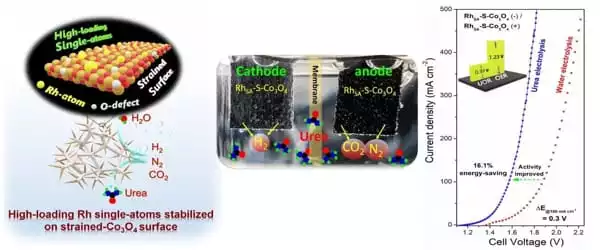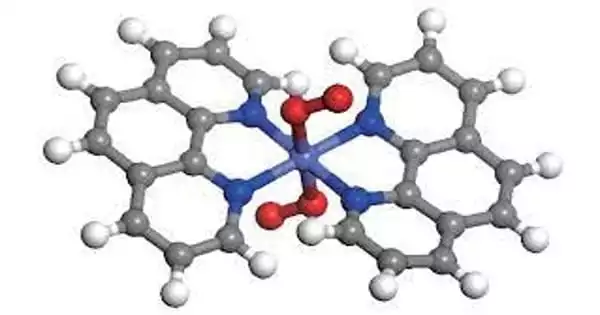While hydrogen is widely promoted as a zero-carbon alternative fuel, the vast majority of commercial hydrogen fuel production is derived from the refining of fossil fuels. The limited supply of fossil fuels and their negative environmental impact have prompted researchers to develop alternative technologies for producing hydrogen fuel in an environmentally friendly manner.
This type of “green hydrogen” can be created by electrolyzing water, which is abundant in nature, with electricity derived from a renewable energy source. The sluggish oxygen evolution reaction (OER), which requires a high thermodynamic voltage of 1.23 V, limits the efficiency of water electrolysis significantly.
Due to the thermodynamically favorable (0.37 V, thermodynamic voltage) conditions of urea electrolysis, replacing sluggish water electrolysis with urea oxidation reaction (UOR) offers great promise for saving energy for hydrogen generation. There is also the benefit of reducing urea contamination, as approximately 2,200 billion tons of urea-rich wastewater are discharged into the river each year. To speed up the oxidation process, noble metal catalysts such as platinum (Pt) and rhodium (Rh) are used. However, these noble metal catalysts are very expensive and perform poorly over long periods of time.
A new single-atom catalyst can produce hydrogen from urea at an exceptional rate. Liquid nitrogen quenching introduces tensile-strain on the surface of oxide support, stabilizing ultra-high loading of single metal atom sites.
LEE Hyoyoung
Single-atom-catalysts (SACs) have recently demonstrated superior performance when compared to nanomaterials-based counterparts. However, the low metal loading (< 3 wt percent) of SACs, caused by the tendency of surface atoms to migrate, poses a significant challenge for a scalable application.
The IBS research team developed a strategy to achieve ultra-high loading of single metal atom sites, led by Associate Director LEE Hyoyoung of the Center for Integrated Nanostructure Physics within the Institute for Basic Science (IBS) at Sungkyunkwan University. This was accomplished by applying surface strain to the support material, resulting in exceptional urea oxidation assisted hydrogen fuel generation.
“To generate tensile strain on the surface of cobalt oxide, we used a liquid nitrogen quenching method (Co3O4). Because of thermal expansion, the ultra-high cooling rate expands the lattice parameter of the quenched sample, causing tensile strain on the oxide surface. When compared to the pristine Co3O4 surface, the strained surface stabilized a ~200 percent higher loading of rhodium single atom sites. We discovered that when compared to the pristine surface, the strained surface significantly increases the migration energy barrier of RhSA, inhibiting migration and agglomeration “says the study’s first author, Ph.D. candidate Ashwani Kumar.

“We were ecstatic to discover that the high loading of RhSA stabilized on the strained Co3O4 surface demonstrated exceptional UOR activity and stability in both alkaline and acidic media, far outperforming commercial Pt/C and Rh/C. This surface strain strategy in the field of SACs had never been reported prior to our findings “Associate Director Lee, the study’s corresponding author, elaborates.
The researchers also discovered that this strategy for high-loading single-atom sites was not limited to rhodium. The strained surface strategy was also used to stabilize ultra-high loading of other noble metals such as platinum, iridium, and ruthenium-based single-atom sites, paving the way for more general application of this discovery.
The team of researchers assessed the catalytic efficiency and working voltage required for urea oxidation using this new catalyst. The advanced catalyst (RhSA on strained Co3O4) required only 1.28 V vs. reversible hydrogen electrode (RHE) to achieve a current density of 10 mA (milliampere) per cm2 of the electrode, which was lower than the 1.34 and 1.45 V requirements of commercial Pt and Rh catalysts, respectively.
Furthermore, the catalyst demonstrated long-term stability for 100 hours without structural change. The researchers used density functional theory simulation to investigate the origin of the new catalyst’s exceptional performance, which was discovered to be due to superior urea adsorption and stabilization of CO*/NH* intermediates. Furthermore, urea electrolysis saved 16.1% more energy than water electrolysis for hydrogen generation.
Lee, Associate Director, explains: “This research provides a general strategy for stabilizing high-loading of single-atom sites for scalable applications, which has been a long-standing issue in the field of SACs. Furthermore, this research brings us one step closer to a carbon-free and energy-saving hydrogen economy. This highly efficient urea oxidation electro-catalyst will assist us in overcoming the long-term challenges of the fossil fuel refining process: producing high-purity hydrogen for commercial applications at a low cost and in an environmentally friendly manner.”





